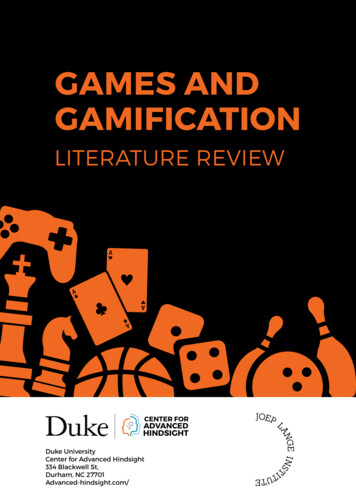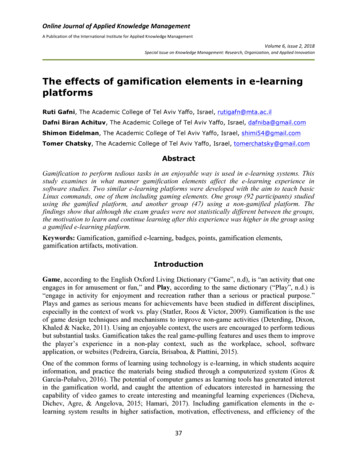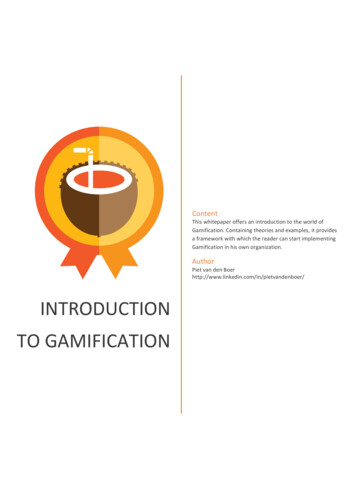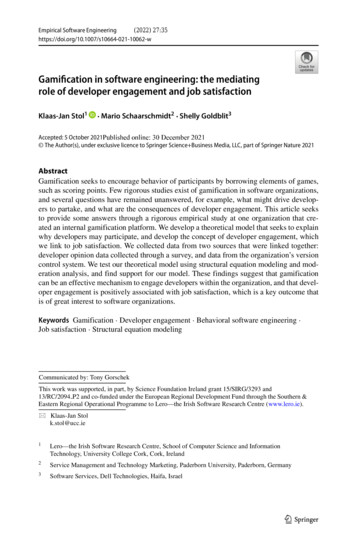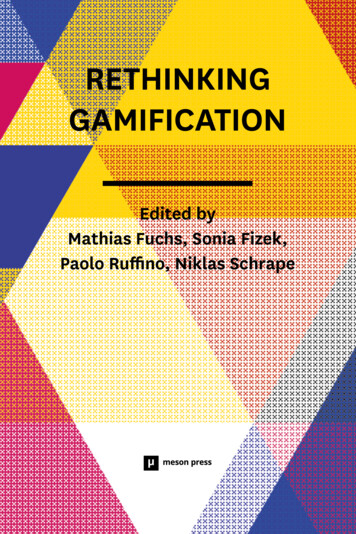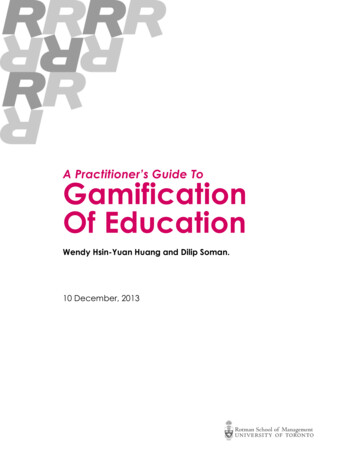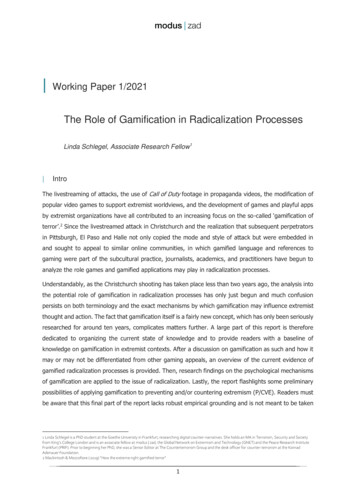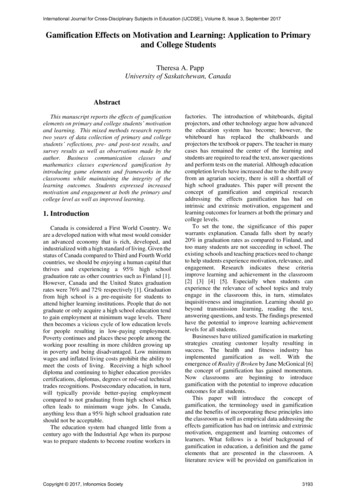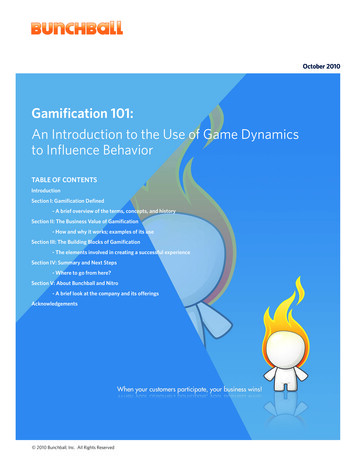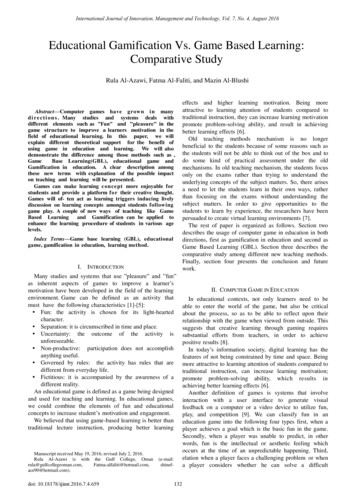
Transcription
International Journal of Innovation, Management and Technology, Vol. 7, No. 4, August 2016Educational Gamification Vs. Game Based Learning:Comparative StudyRula Al-Azawi, Fatma Al-Faliti, and Mazin Al-Blushi Abstract—Computer games have grow n i n manyd i r e c t i o n s . Many studies and systems deals withdifferent elements such as ”Fun” and ”pleasure” in thegame structure to improve a learners motivation in thefield of educational learning. In this paper, we willexplain different theoretical support for the benefit ofusing game in education and learning. We will alsodemonstrate the difference among those methods such as ,GameBase Learning(GBL), educational game andGamification in education. A clear description amongthese new terms with explanation of the possible impacton teaching and learning will be presented.Games can make learning c onc e pt more enjoyable forstudents and provide a platform f or their creative thought.Games will of- ten act as learning triggers inducing livelydiscussion on learning concepts amongst students followinggame play. A couple of new ways of teaching like GameBased Learningand Gamification can be applied toenhance the learning procedure of students in various agelevels.Index Terms—Game base learning (GBL), educationalgame, gamification in education, learning method.I.INTRODUCTIONMany studies and systems that use ”pleasure” and ”fun”as inherent aspects of games to improve a learner’smotivation have been developed in the field of the learningenvironment. Game can be defined as an activity thatmust have the following characteristics [1]-[5]: Fun: the activity is chosen for its light-heartedcharacter. Separation: it is circumscribed in time and place. Uncertainty: the outcome of the activity isunforeseeable. Non-productive: participation does not accomplishanything useful. Governed by rules: the activity has rules that aredifferent from everyday life. Fictitious: it is accompanied by the awareness of adifferent reality.An educational game is defined as a game being designedand used for teaching and learning. In educational games,we could combine the elements of fun and educationalconcepts to increase student’s motivation and engagement.We believed that using game-based learning is better thantraditional lecture instruction, producing better learningManuscript received May 19, 2016; revised July 2, 2016.Rula Al-Azawi is with the Gulf College, l.com,ace90@hotmail.com).doi: ts and higher learning motivation. Being moreattractive to learning attention of students compared totraditional instruction, they can increase learning motivationpromote problem-solving ability, and result in achievingbetter learning effects [6].Old teaching methods mechanism is no longerbeneficial to the students because of some reasons such asthe students will not be able to think out of the box and todo some kind of practical assessment under the oldmechanisms. In old teaching mechanism, the students focusonly on the exams rather than trying to understand theunderlying concepts of the subject matters. So, there arisesa need to let the students learn in their own ways, ratherthan focusing on the exams without understanding thesubject matters. In order to give opportunities to thestudents to learn by experience, the researchers have beenpersuaded to create virtual learning environments [7].The rest of paper is organized as follows. Section twodescribes the usage of computer game in education in bothdirections, first as gamification in education and second asGame Based Learning (GBL). Section three describes thecomparative study among different new teaching methods.Finally, section four presents the conclusion and futurework.II. COMPUTER GAME IN EDUCATIONIn educational contexts, not only learners need to beable to enter the world of the game, but also be criticalabout the process, so as to be able to reflect upon theirrelationship with the game when viewed from outside. Thissuggests that creative learning through gaming requiressubstantial efforts from teachers, in order to achievepositive results [8].In today’s information society, digital learning has thefeatures of not being constrained by time and space. Beingmore attractive to learning attention of students compared totraditional instruction, can increase learning motivation;promote problem-solving ability, which results inachieving better learning effects [6].Another definition of games is systems that involveinteraction with a user interface to generate visualfeedback on a computer or a video device to utilize fun,play, and competition [9]. We can classify fun in aneducation game into the following four types first, when aplayer achieves a goal which is the basic fun in the game.Secondly, when a player was unable to predict, in otherwords, fun is the intellectual or aesthetic feeling whichoccurs at the time of an unpredictable happening. Third,elation when a player faces a challenging problem or whena player considers whether he can solve a difficult
International Journal of Innovation, Management and Technology, Vol. 7, No. 4, August 2016problem or achieve a difficult goal. Finally, honor for theplayer. There is a feeling of satisfaction when a playerreceives social praise or honor, such as “the player is praised”or the player achieves first place [2].In this section, we have noticed that the use of games ineducation provides five keys of claiming [10]: Games are built on sound learning principles. Games provide more engagement for the learner. Games provide personalized learning opportunities Games teach 21st century skills. Games provide an environment for authentic andrelevant assessment.Despite the use of educational computer games inteaching many subjects, still there is a need for moregames to teach several other subjects.In the next section, we will explain benefit of usinggame in education.A. Benefits of Games in EducationVideo games have great positive potential in addition totheir entertainment value and there has been considerablesuccess when games are designed to address a specificproblem or to teach a certain skill. Video games canclearly attract the attention of children and adolescents. Forover twenty years researchers have been using games ineducation, providing the following reasons as to why gamesare useful tools in teaching and learning concept. Forinstance [11]-[16]: Games can be used as research and/or measurementtools. Games attract participation by individuals across manydemographic boundaries (e.g., age, gender, ethnicityand educational status). Games can assist children in setting goals, ensuringgoal rehearsal, providing feedback, reinforcement, andmaintaining records of behavioral change. Games can be useful, as they allow the researcher tomeasure performance on a very wide variety of tasks,and can be easily changed, standardized andunderstood. Games can be used when examining individualcharacteristics such as self-esteem, self-concept, goalsetting and individual differences. Games are fun and stimulating for participants.Consequently, it is easier to achieve and maintain aperson’s undivided attention for long periods of time. Games also allow participants to experience novelty,curiosity and challenge. This may stimulate learning Games may help in the development of transferable IT skills Games can act as simulations. These allow participantsto engage in extraordinary activities and to destroy oreven die without real consequencesB. Gamification in EducationGamificaiton is the practice of using game designelements, game mechanics and game thinking in non-gameactivities to motivate participants. For the purpose of thisarticle, we will be discussing gamification in education.There are many examples of how gamification motivatesbehavior in loyalty programs, marketing and even recyclingprograms.On a basic level, gamification techniques tap into andinfluence peoples natural desires for competition,achievement, recognition and self-expression. Gamificationappears to be making a leap from game-play to theworkplace at a great pace. A growing number oforganizations are adopting gaming techniques and gamestyle rewards in order to motivate and incentive employeesand customers [17].We could define gamification in a simple way as it is theuse of game design elements, game thinking and gamemechanics to enhance non-game contexts. This is the mainfunction that gamification could provide to enhance asituation through the use of gaming mechanics, the benefitsof gamification include: a) increased engagement; b) highermotivation levels; c) increased interaction with the user(customer or employee); and d) greater loyalty [18].Young learners gain skills and a method to learn usinggames in their everyday life but however they have touse other methods to be successful in school or at university.Somehow this situation can be put into question althoughteachers and researchers have recognized this fact for almostfive years using the term gamification. [5].Educational gamification proposes the use of game-likerule systems, player experiences and cultural roles to shapelearners behavior. In the previous research study [19],researcher found that many children used a trial-and-errorstrategy through the games. For this reason, gamifying acourse would be a great help to primary students by takingadvantage of the motivational power of games and applyingit to the motivational problems in education so thatsuccessful learning can take place [20].In the classroom, gamification has been integrated in amore authentic manner as some classrooms have become aliving, breathing game. Gamification systems likeClassCraft add an adventure game layer on top of theexisting course infrastructure. Students create a character,play as part of a team, and gain experience points andrewards based on class-related behaviors. Students arerewarded for helping other students, producing exemplarywork, etc. Likewise, students can receive consequences forbehaviors that are inconsistent with the desired learningenvironment [21].Another popular interest in gamification is alsoreflected in an academic context: the number ofpapers published on gamification is growing. Thissuggests that gamification is becoming a more popularsubject for academic inquiry [21]. Gamification has beendefined as a process of enhancing services with(motivational) affordances in order to invoke gamefulexperiences and further behavioral outcomes [21].According to this conceptualization, gamification can beseen to have three main parts:1) The implemented motivational affordances2) The resulting psychological outcomes3) The further behavioral outcomesFig. 1 illustrates the steps in Gamification [21].Fig. 1. Gamification steps.133
International Journal of Innovation, Management and Technology, Vol. 7, No. 4, August 2016C. Game Based Learning (GBL)Game Based Learning (GBL) is being used to encouragestudents to participate in learning while playing, and makethe leaning process more interesting by adding fun to thelearning process. It has a positive effect on cognitivedevelopment [22]. Game and courses are combined becausetraditional learning process is boring and game-basedlearning can improve learning motivation of students. Whenstudents enter into a flow state in playing, theirconcentration is higher than usual [23]. Game-BasedLearning is not just about using games for review andreinforcement. While that is an important and usefulcomponent, it has been going on for a long time, and is notwhat has really changed. What is new and different andmakes people really excited is that computer games can nowbe used for primary learning of really hard subjects,including people management, difficult-to-learn software,complex financial products, and intricate social interactions[24].GBL is increasingly used for the following areas [25],[26]: Material that is dry, technical and boring Subject matter that is really difficult Audiences that is hard to reach Difficult assessment and certification issues Complex understanding process Sophisticated what if analyses Strategy development and communication Increasing the learning interest and motivation ofstudentsGame-based learning makes people feel as if they areplaying computer games. In the learning process, weobserve two important elements which are interesting andfun. Actually, games can help learners to being in aneffective learning environment that is at ease and withstronger learning motivation [27], so that learners can usedigital game-based learning to develop the basic techniquesand knowledge in specific fields necessary in the digitaltechnology age [28]. Children also believe that digitalgame- based learning helps them to learn faster, and havegreater interest in focusing on learning topics. We believethat game-based learning can considerably help middleschool science, technology, and mathematics education[6].Most students for example feel that mathematics is adifficult subject, and many students lose their learningmotivation in response to the repetitive and monotonousmathematical learning in the classroom, having lost moralefor learning mathematics [29]. If it is possible to use digitalgame-based learning for mathematics, students not onlythink that mathematics has become more interesting, butalso teachers and parents think that if students use gamesto learn mathematics, it can effectively enhance theirmathematical knowledge and abilities [6].III. COMPARATIVE ANALYSISThe purpose of this section is to analyze the differenceamong gamification in education and GBL in manycompromising categories.Gamification is turning the learning process as a wholeinto a game, while GBL is using a game as part of thelearning process.Gamification turns the entire learning process into agame. It takes game mechanics and gameplay elements andapplies them to existing learning courses and content inorder to better motivate and engage learners. Examples ofthese mechanics include: Achievement badges, Points,Leaderboards, Progress bars and Levels/quests. In theory,one can gamify any activity, not just learning ones. Indeed,everything from fitness apps to LinkedIn profile pages canand have been gamified to increase user participation andengagement. Unlike gamification, game- based learningrelates to the use of games to enhance the learningexperience. Educators have been using games in theclassroom for years.All of the studies in education/learning contextsconsidered the learning outcomes of gamification as mostlypositive, for example, in terms of increased motivation andengagement in the learning tasks as well as enjoyment overthem. However, at the same time, the studies pointed tonegative outcomes which need to be paid attention to, suchas the effects of increased competition, task evaluationdifficulties, and design features [21].Gamification is different from Learning Based Gamesbecause it takes the entire learning process and turns it intoa game. To do this instructional designers will use gamedesign elements which are digital objects and elementsthat make an experience game like.Examples ofgamification design elements include: fixed rules, negativeconsequences, ranks, player effort, reputation and variableoutcomes. Instructional designers will also use gamemechanics and game thinking. Game mechanics are rulesand feedback loops which include tactics like point systems,leaderboards, levels, rewards and time constraints. Gamethinking, on the other hand, aims to create immersiveexperiences like storytelling, challenges and requests.This is where it gets slightly confusing because learnedbased games also use the aforementioned gamingmechanics, elements and thinking. The difference is thatlearning based games will turn a singular learningobjective from an e-learning course into a gamewhereas Gamificaiton takes the entire eLearning processand turns it into a game. Table I helps to furtherdistinguish Gamification and game based learning forfurther clarification.TABLE I: COMPARATIVE ANALYSIS TABLEComparisonpointsGamification in educationConceptGamification is the idea of addinggame elements of a non-gamesituation. They reward users forcertain behaviors.Game based learningEducational gameUse of games to enhance thelearning experienceAre designed to helppeople to learn about a certainsubject, expand concept,reinforce development,understand historical event orculture.134
International Journal of Innovation, Management and Technology, Vol. 7, No. 4, August 2016ObjectiveLearn a motivation fromgameTo achieve in the gamemotivate studentsFor teaching the basic andcertain subjectChallengeLooking for a new way toapproach challengesChallenges are part of thegame must be solved.May or may notCharacterPlayer avatar weak story1.Progressing to differentlevels 2.Scores 3.Avatars4.Virtual currencies 5.Competition with friendsCharacters situation1.Motivation 2.Relevantpractice 3.Specific timely4.Story, emotional 5.Gamegoals , challengesNarrative , characters1.Learninig 2.problemsolving 3.Adaptation4.Interaction 5.enjoyment andpleasure.1.Better LearningExperience 2.BetterLearning Environment3.Instant Feedback4.Prompting Behavioral Change5.Can Be Applied For MostLearning Needs1.Increases A ChildsMemory Capacity2.Computer , Simulation Fluency3.Helps With Fast StrategicThinking , Problem-Solving4.Develops Hand-EyeCoordination5.Skill-Building (e.g. mapreading)TechniquesBenefits1.Motor Skills 2.SocialDevelopment 3.Focus andMemory 4.Self-Esteem5.CreativityRewardsEarn experience points and levelupLevels , costsCheaper , easierIntrinsically rewards,Losing may or may not bepossible because the point is tomotivate people to take actionand learn.Expensive , hardContentFeatures are added to theLMS or any other system.Usually morphed to fit the storyand scenes of the gameAll levels, expensivea structured, competitiveactivity, game played within acontext of a story or a createdhistory.ExamplesJoanne Chen, Lifesaver,Ashi Tandon, AlphonsoHendricks, Bob Kaart, ChristinaStephenson,Nick RussellSimCity, Civilization,World of Warcraft,Mineraft, and PortalBody parts, color reactor,Dragon Box, Code Spells,Scribble NaughtsScoring pointsthis technology in their daily interactions [10].As a result, gamification is touted as a next generationmethod for marketing and customer engagement in populardiscussion. The usage of game elements or game mechanicsdesign depends on the systems main contexts and purposes.In general the most used elements in gamified applicationsare feedbacks, leaderboards, points, and levels. The keyadvantage of gamification is the low cost of developmentand the possibility of making learning content moredelicious or interesting using game elements. In traditionalinstructional methodology where the lecture classes areperceived to be boring by students, the gamificationtechnology has a great advantage to solve the problem [30].IV. CONCLUSION AND FUTURE WORKThis paper aimed at clarifying the importance of usingnew trends in education. We have noticed that creating aneffective educational game entails much more than simplycreating an engaging game and building in ageappropriate educational content. Through gamification, wecan not only create a mindset that encourages students to trynew things and not be afraid of failing, but also can enablestudents to engage in enjoyable experiences for the purposeof learning. In addition, gamification is an innovativeapproach to learning, as new technologies and applicationsare continuously emerging, it is still developing. Furtherstudies shall continue to examine the new mechanics andnew applications associated with emerging gamificationtechnologies [20]. However, the most important goal of anydigital game-based instructional material is to increaselearning. Compared with traditional lectures, digital gamebased approaches can indeed produce better learning effects,which underscore the need to develop appropriateinstructional materials [6]The next generation of jobs will be characterized byincreased technology use, extensive problem solving, andcomplex communication. These are skills that go beyondtypical reading, writing, and arithmetic of years past. It’s notonly what students need to learn, e.g. shifting, but also howand when they learn. Students are growing up with laptops,tablets, cell phones, and video calls, and they expect to useREFERENCES[1][2][3][4][5][6]135R. S. J. Bourgonion, M. Valcke, and T. Schellens, “Exploring theacceptance of video games in the classroom by secondary schoolstudents,” in Proc. ICCE2009, pp. 651–658.R. Takaoka, T. Okamoto, and M. Shimokawa, “A framework of educational control in game-based learning environment,” in Proc. the2011 11th IEEE International Conference on Advanced LearningTechnologies, ICALT 2011, pp. 32–36, 2011.J. K. A. Ogan, V. Aleven, and C. Jones, “Instructional negotiationwith virtual humans: The effect of social goals on gameplay andlearning,” in Proc. ITS2010, 2010.C. Seelhammer and M. Niegemann, “Playing games to learn - does itactually work?” in Proc. ICCE2009, pp. 675–681.K. Erenli, “The impact of gamification: A recommendation ofscenarios for education,” in Proc. 2012 15th InternationalConference on Interactive Collaborative Learning, ICL 2012, 2012.H. R. Chen, C. H. Jian, W. S. Lin, P. C. Yang, and H. Y.Chang, “Design of digital game-based learning in elementary school
International Journal of Innovation, Management and Technology, Vol. 7, No. 4, August 19][20][21][22][23][24][25]math-ematics,” in Proc. 2014 7th International Conference on UbiMedia Computing and Workshops, pp. 322–325, 2014.U. Jayasinghe and A. Dharmaratne, “Game based learning vs.gamification from the higher education students’ perspective,” inProc. International Conference on Teaching, Assessment andLearning for Engineering, no. August, pp. 683–688, 2013.E. U. Member and S. Iceac, “Innovation and creativity ineducation and training in the EU member states: Fostering creativelearning and supporting innovative teaching literature review oninnovation and creativity in E & T.”S. S. Shabanah, J. X. Chen, H. Wechsler, D. Carr, and E. Wegman,“Designing computer games to teach algorithms,” in Proc. 2010Seventh International Conference on Information Technology:New Generations, 2010, pp. 1119–1126.K. L. Mcclarty, P. M. Frey, and R. P. Dolan, “A literature review ofgaming in education research report,” June, 2012.R. Vacca, M. Bromley, J. Leyrer, M. Sprung, and B. Homer,Designing Games for Emotional Health, �A Future Lab Literature Review, p. 139, 2010.D. Moursund. (2006). Introduction to using games in education: Aguide for teachers and parents. [Online]. 6. pp. 1–155. andle/1794/3177A. Introduction, “Teaching Toolkit,” October 2011.K. Facer, “Computer games and learning,” Screen, vol. 6, p. 35, 2006,December 2007.M. Griffiths, “The educational benefits of videogames,” Educationand Health, vol. 20, no. 3, pp. 47–51, 2002.Gartner, “Gartner says by 2015, more than 50 per cent oforganizations that manage innovation processes will gamify thoseprocesses,” 2011.APM Thames Valley, Introduction to Gamification, 2014.J. Sandberg, M. Maris, and K. de Geus, “Mobile English learning:An evidence- based study with fifth graders,” Computers andEducation, vol. 57, no. 1, pp. 1334–1347, 2011.C.-H. Su and C.-H. Cheng, “A mobile game-based insect learningsystem for improving the learning achievements,” Procedia - Socialand Behavioral Sciences, vol. 103, pp. 42–50, November 2013.J. Hamari, J. Koivisto, and H. Sarsa, “Does gamification work? Aliterature review of empirical studies on gamification,” in Proc. theAnnual Hawaii International Conference on System Sciences, 2014,pp. 3025–3034.W. C. Lin, J. Y. Ho, C. H. Lai, and B. S. Jong, “Mobile gamebased learning to inspire students learning motivation,” in Proc.2014 International Conference on Information Science, Electronicsand Electrical Engineering, ISEEE 2014, vol. 2, pp. 810–813, 2014.K. Squire, “Video games in education,” International Journal ofIntelligent Games and Simulation, vol. 2, 2003.M. Prensky, “The digital game-based learning revolution,” pp. 1–20,2001.F. Ke, “Alternative goal structures for computer game-based learning.”International Journal of Computer-Supported CollaborativeLearning, vol. 3, pp. 429-445, 2008.136[26] H. Andreas and M. Ebner, “Successful implementation of usercentered game based learning in higher education: an example fromcivil engineering,” Computers and Education, vol. 49, no. 3, pp.873-890, November 2007.[27] H. C. Hsiao, “A brief review of digital games and learning,” inProc. First IEEE International Workshop on Digital Game andIntelligent Toy Enhanced Learning, 2007.[28] C. J. An, Y.-J. Bonk, “Finding that special place: Designing digitalgame-based learning environments,” TechTrends, vol. 53, no. 3, pp.43–48, 2009.[29] V. Kalloo, Kinshuk, and P. Mohan, “Personalized game basedmobile learning to assist high school students with mathematics,” inProc. IEEE International Conference on Advanced LearningTechnologies, 2010, pp. 485–487.[30] G. Surendeleg, V. Murwa, H. K. Yun, and Y. S. Kim, “The role ofgamification in education a literature review,” ContemporaryEngineering Sciences, vol. 7, no. 2932, pp.1609–1616, 2014.Rula Al Azawi is Senior Lecturer and programmeleader of computer science department in Gulf Collageaffiliated with Stafford Shire university/UK, where shehas been since 2005. She received a B.Sc. from AlMansourl University in 1995, and a M.Sc. in softwareengineering from National Computer Center/ HigherEducational Institute of Computer and InformationResearch in 2000. She received her Ph.D. in IntellegentSoftware Engeering from De-Montfort University / UK in 2015.She has over fifteen years of teaching experience. Ten years of which assenior lecturer with proficiency in teaching several computer science topicsof UK modules. Five years as a lecturer in Jordan and Iraq. Actively doresearching in the areas of serious games, educational games, gamedevelopment methodology and Agent Oriented Software Engineering(AOSE) and their applications on the game domain. Furthoremore, she hasworked in Quality Assurance to create Self Evaluation Document (SED) forcomputing department and with Ministry of Higher Education in Oman.Mazin Albalushi is an Omani mobile developer. He has four years of workexperience. He is a student in Gulf College affiliated with StaffordshireUniversity/UK and will graduate in 2016/2017. He is aiming to be aspectacular and innovative and one of the best app programmers.Fatma Alfuliti has four years’ experience of computer science. She is astudent in Gulf College affiliated with Staffordshire University/UK and willgraduate in 2016/2017. She has experience of mobile application. It aims toexcel in creating innovative applications and creative.
B. Gamification in Education . Gamificaiton . is the practice of using game design elements, game mechanics and game thinking in non-game activities to motivate participants. For the purpose of this article, we will be discussing gamification in education. There are man
